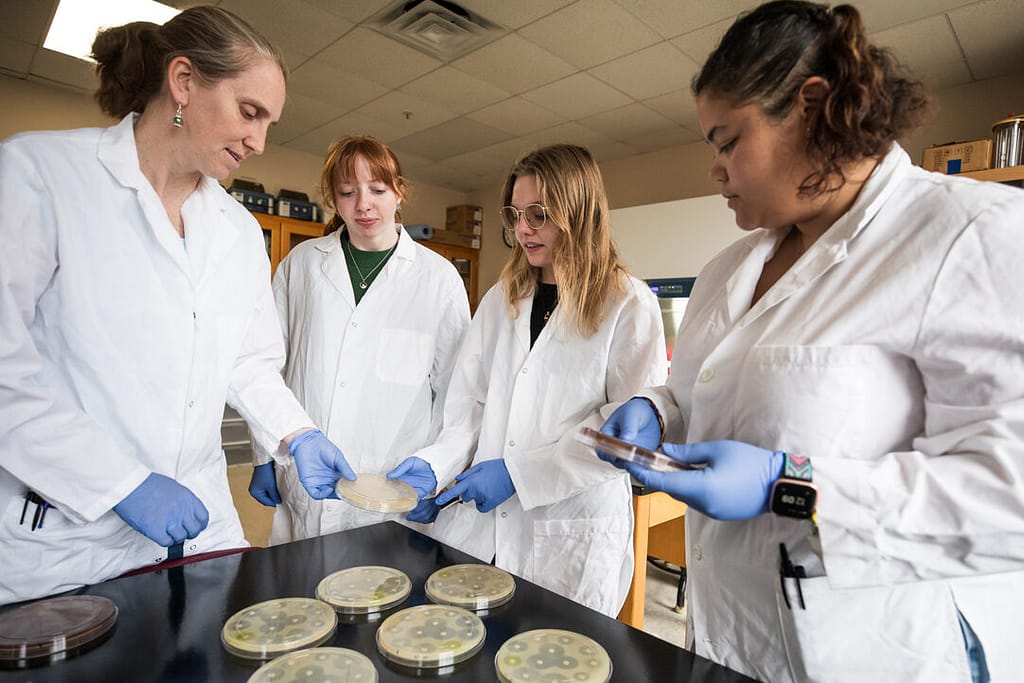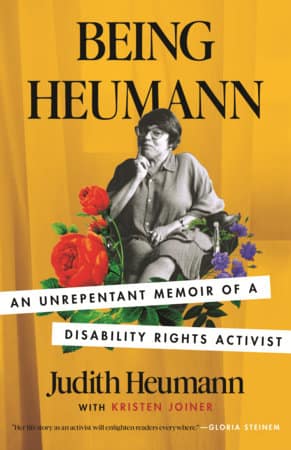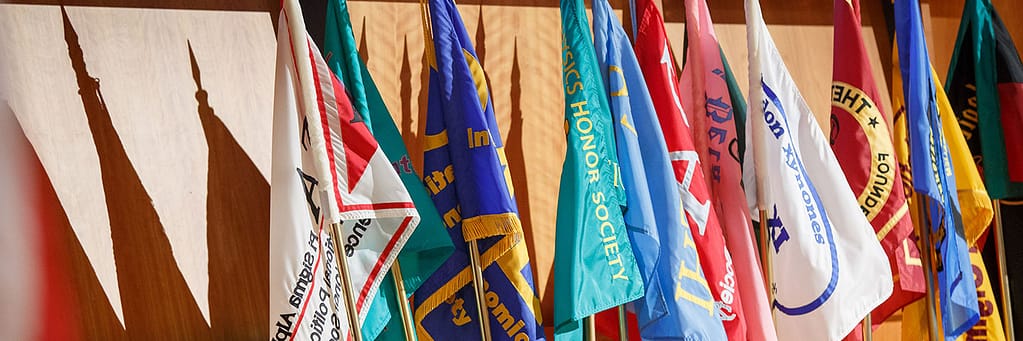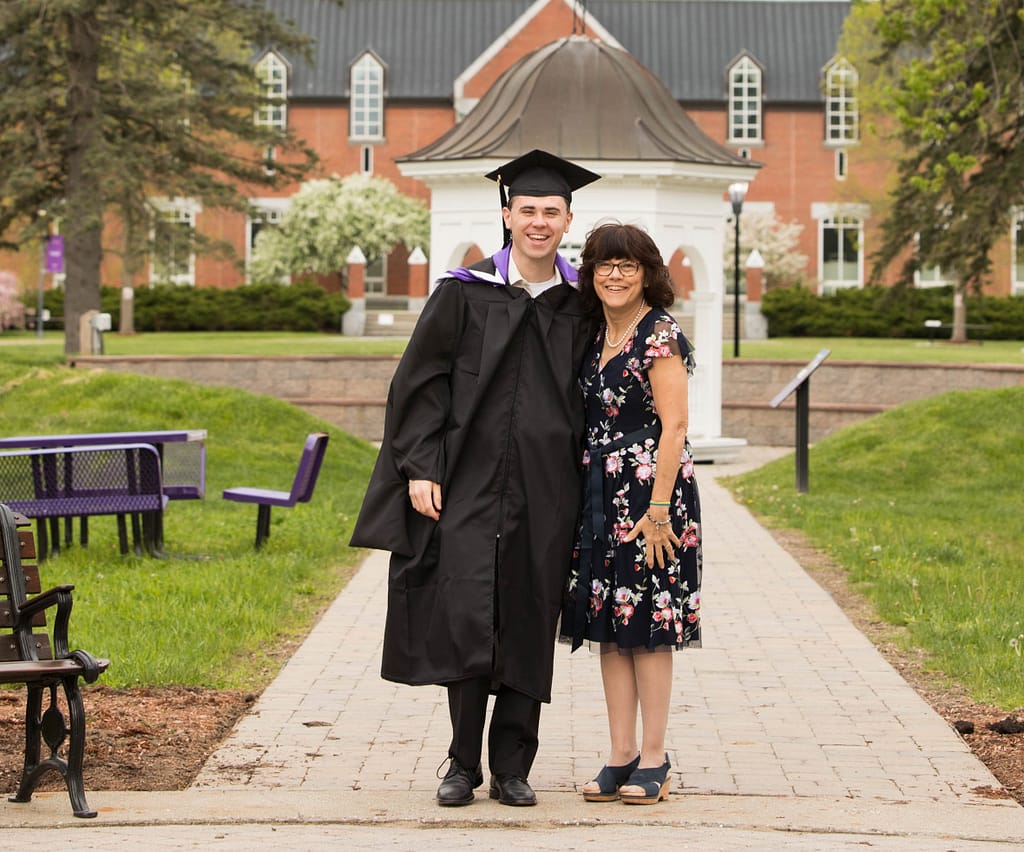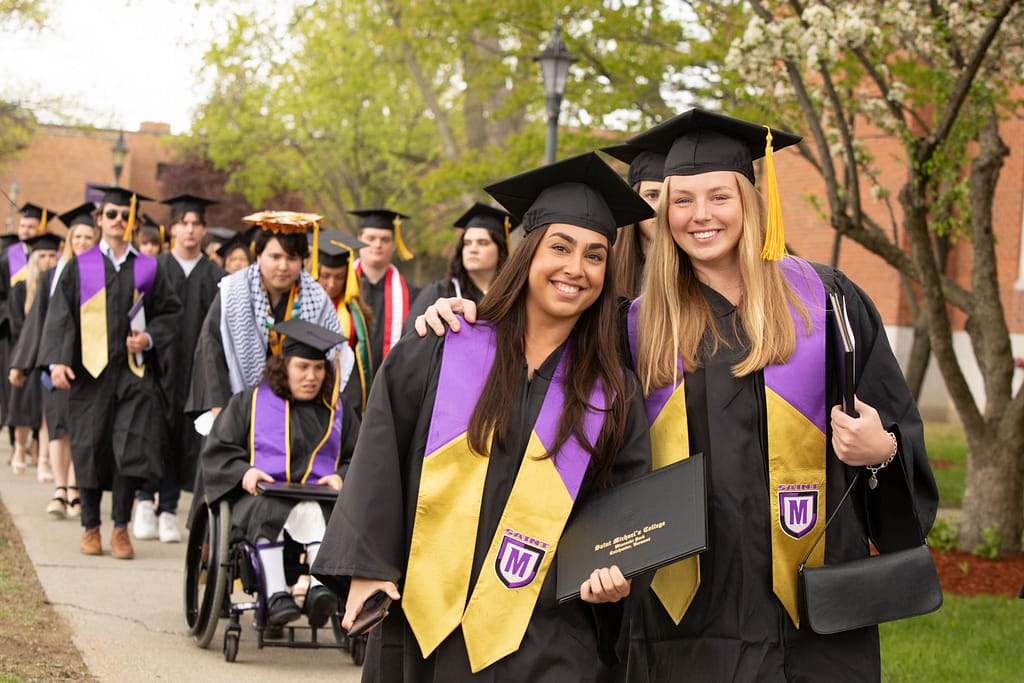Overcoming obstacles a big part of summer research
Luncheon with peers and mentors offers students chance to share achievements, or challenges met, after many weeks of study on broad range of topics
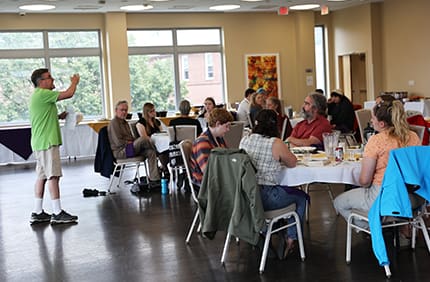
Jeffrey Trumbower, vice president for Academic Affairs, left, opens the research presentation session Thursday. In the large photo behind the headline he later listens to a student presenter. (all photos by Lauren Read)
Students conducting summer research with Saint Michael’s faculty members described challenges and achievements from their projects during a July 27 lunch in the Dion Family Student Roy Room.
Jeffrey Trumbower, vice president for academic affairs, launched the Thursday program at about 12:30 p.m. after everybody had enjoyed a Sodexo-provided meal and one another’s company. Dean Gretchen Galbraith was among the guests.
Trumbower reminded researchers of his expectation that they present their work in some formal venue, whether at next year’s spring Academic Symposium or a national or regional professional meeting.
Then, Professor Trish Siplon of political science reminded students of post-graduate opportunities, including several that are research-based and therefore ideal for this group. She spoke of prestigious fellowships such as Fulbright or Rhodes Scholarships, along with others such as State Department Critical Language Scholarships, Marshall or Truman Scholarships, and others, and encouraged them to ask her more about it later, with deadlines for many in early fall.
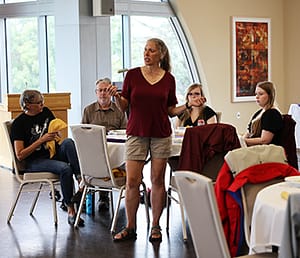
Trish Siplon encourages applications for prestigious research scholarships.
On June 7 at the start of their work, many of the same students who attended this late-July lunch had shared some of their goals for their research during a campus brunch. Since that time, they have been working with faculty academic mentors thanks to grants through the College’s Academic Affairs office, and clearly have had a busy summer.
As he does each year, Trumbower stressed how an important and invaluable part of the learning process for researchers and in life is meeting challenges and roadblocks, recalibrating and moving forward productively. A majority of the presenters described encountering challenges and how they dealt with them.
Following, in the order they volunteered to share updates on Thursday, are researcher and mentor names, original project hopes (as reported by Elizabeth Murray ‘13 of marketing/communications in June), and brief notes on how they said the work has been going:
Dakota Thomas ’24: Interpreting Constructs: A Phenomenology of Race; Faculty mentor: Professor Katie Kirby, Philosophy and Ethics Department.
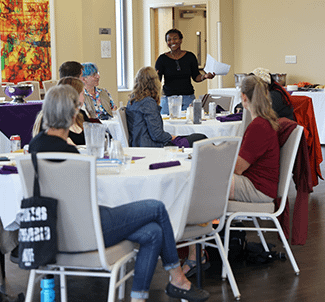
Dakota Thomas enjoys making a point during her presentation.
Thomas looked at how the idea of race exists in society and affects humans’ values, studying the construct of race through history and philosophy to point to specific examples of how or why race had an impact on events, ideas, or values. The authors she read highlighted “Our interconnectedness and the burden of truth we all have,” she said, relating modern current events in American politics to her expanded insights. From the readings, she realizes “we live in a racialized world, and no one is outside that realm or can live in that world without doing this kind of reflection. It’s a day-to-day process.”
*
Celia Durgan ’24: Use of Metaphors and Visual Art Among Bloggers with Chronic Pain: A Content Analysis; Faculty mentor: Professor Sarah Nosek, Psychology Department.
Professor Nosek has been conducting research on the potential for people with chronic pain to use expressive writing to help them process, describe and cope with their experiences. Durgan dived further into several aspects of that research by analyzing chronic pain blogs for patterns of metaphor/language and art use. Durgan is interested in art therapy, so the goal of this research is to better understand how people with chronic pain communicate about those challenges and attempts to cope with the pain. An early roadblock, she said, was struggling to find blog posts to study, but Durick librarian Kirstin Hindes taught her good approaches to searching blog platforms, which got her rolling. She concluded that research supports her hypothesis that people use blogs to deal with pain, and said she will use her summer work for a capstone project with Nosek in the coming academic year.
*
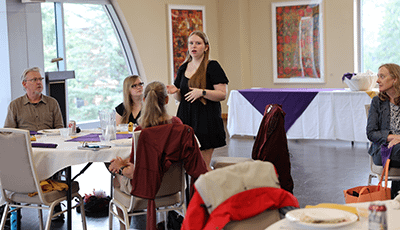
Dean Gretchen Galbraith, far right, hears Kaitlyn’s research update.
Kaitlyn Folsom ’24: Easily Overlooked: An assessment of how the state of Vermont supported individuals with ASD during the COVID-19 pandemic; Faculty mentor: Professor Trish Siplon, Political Science Department and Public Health Program
Folsom explored how Vermont tried to support individuals with Autism Spectrum Disorder (ASD) during the COVID-19 pandemic and whether people with ASD felt that Vermont provided adequate accommodations and support during the pandemic years and how they have experienced any support efforts. At Thursday’s lunch she described key themes that emerged as coping methods among those she studied, such as “masking” and “camouflaging,” with many of the surveyed reporting the need for more personalized support from healthcare providers, she said. Her work is leading to a paper
*
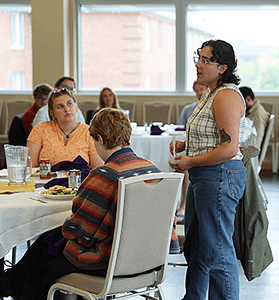
Another presenter stands and delivers.
Sophia Meimaris ’24: Inside Sebald: A Creative Exploration of History and Aesthetics; Faculty mentor: Professor Nat Lewis, English Department
Meimaris has been seeking to understand the literary, historical, and aesthetic complexities present in German author W. G. Sebald’s novels, analyzing elements of the novels to break down the author’s understanding of the human experience – and even adopt his writing style to deepen her textual and thematic understandings of his books. Themes she aimed to explore at the outset included historiography and literature, fact and fiction, and aesthetics and memory. After closely analyzing Sebald’s style, Meimaris said, she “recreated his writing style” and “got inside his novels.” She also produced interactive story maps that “allowed me to play with his writing style,” furthering her understanding of that style and of European literature in general.
*
Jonathon “Jack” Macdonald ’25 and Jack Conroy ’24: Characterizing the insulin-sensitizing bioactivities of Vanilloids in model human liver cells; Faculty mentor: Professor Christopher Dieni, Chemistry Department
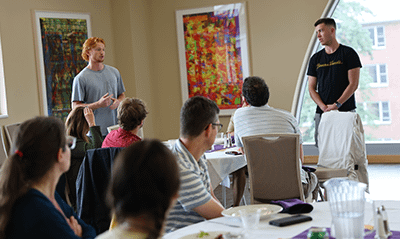
“The Jacks” — Macdonald, left, and Conroy — describe their insulin-resistance work in the Dieni lab.
Conroy and Macdonald initially aimed to work on different aspects of research into insulin resistance – a project that Professor Dieni has been conducting for a number of years, while their peer researcher Jamie Hearn ’26 (not present this day) sought to explore ways to create an early detection test for insulin resistance that is affordable, reliable and minimally invasive. However, the two Jacks reported, they found key biomarkers difficult to detect in several assays and eventually decided to put that arm of the research on the back burner and focus most on the interventive side of insulin resistance therapy. They explained the problem of culturing a particular cell line, due to their inexperience working with mammalian cell lines, but they found a different type cell to work with other than liver that worked out better. “It was all about optimization on protocols, efficiency – the first half was all about optimization” said Jack Macdonald of this summer’s work. They said their mentor Dieni recently went to a local scientific meeting and found someone else working with the same cell line who helped them answer important questions. “Now we know we can fine-tune our protocols working with cells when we introduce insulin resistance, to know what we are seeing is normal,” Jack Conroy said. The plan to continue the research into next year, they said. Trumbower said the direction-shift they described is “a big part of what we do” in research.
*
Addison Wessinger ’24: Ecological Health Comparisons Between Old Growth Stand and Natural Area; Faculty mentor: Professor Clay Williams, Environmental Studies and Science Department
Among those working to mitigate the impact of climate change and the extinction crisis, one consistent talking point has been how protecting forests and allowing them to reach old-growth status can be beneficial. Wessinger told his research peers how he compared a plot of land in the Saint Michael’s College Natural Area – which has been impacted by humans by farming in recent decades – to a plot of old growth forest nearby, which has not been touched by humans — hoping to show whether old-growth forests have healthier soils and biodiversity indicators than ecosystems with a more recent history of human disturbance. To do that, he said, he took soil samples as indicators of ecological health, processed those in the lab to analyze organic material in them, focusing on phosphorous and nitrogen. Current findings suggest that new growth forests have similar ecological properties to old growth forests, suggesting that fields still in the process of transition could resemble the health of older forest within as soon as 50 years. That’s good news, he said, since they sooner than later will retain water better and promote microorganism growth. “These are big findings for restoration practices and our ability to restore land that has been significantly modified,” Wessinger said. Major challenges in his research this summer included that “field conditions were dreadful some days” with all the recent flooding, which set him back on time.
Anna Juarez ’23 (see large photo at bottom): Does incorporating wastewater pre-treatment methods into Vermont brewers improve their effluent water quality? Faculty mentor: Professor Clay Williams, Environmental Studies and Science Department
Juarez looked at the impact of Vermont breweries – and the wastewater created as a result of brewing beer – on wastewater treatment and management systems and aquatic ecosystems. As part of this, she worked to understand the different permits that regulate the waste byproduct, called effluent, and the steps that breweries in Vermont might take to ensure a cleaner byproduct that is less likely to contaminate lakes and rivers. A significant roadblock she encountered in her work is that the data she needed is not monitored the same at every brewery or treatment facility, so she switched to focus on pre-treatment systems. She described some of those she encountered, but noted how some of the most effective systems are also prohibitively expensive for many smaller breweries. Also, she found permitting is not enforced equally since a cluster of smaller breweries, as on Burlington’s Pine Street, might avoid pre-treatment requirements based on size, but together they create more pollutants than a larger single brewery. “Moving forward, I’d be interested in seeing how these systems might be incorporated on a large scale,” and also in finding ways to make biological pretreatment more economical.
*
Jarrett Sweet ’25: Transphobia and Homophobia: Impact on the Academic Performance of LGBTQIA+ Students; Faculty mentor: Professor Mike Bosia, Political Science Department
Sweet set out to survey LGBTQIA+ youth who attend school in Vermont, as well as faculty and staff. to determine the ways a student’s LGBTQIA+ identity might affect their learning. He planned to analyze if location matters in these experiences and outcomes, with a focus on rural versus urban, and what influence of the child’s community type might be. He told Thursday’s gathering of summer researchers how timely his work is in today’s political climate of transphobia and legislation across the U.S. targeting trans youth. This summer he mainly looked at case studies, including one in Tennessee of a nonbinary student wanting to attend prom but not being able to due to a dress code enforcement; he also looked into a Vermont case involving a transgender athlete in Randolph.
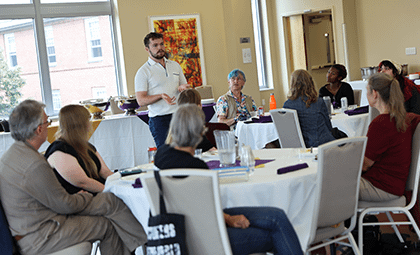
Jarrett Sweet describes his research.
The outcome of a lawsuit in that case not favoring the transgender athlete was a “sad outcome” from his perspective, he said. “Moving forward in the fall, I’m looking forward to getting into schools, seeing students and interacting.” This summer with Bosia he worked on a “one-pager for schools” to provide them information on how to improve safe space in schools for LGBTQ youth. “I’m exited to progress and see where it goes as this is a very hot topic now,” Sweet said.
*
Helene Kristoffersen ’25: Determining the effect of a mutation on subcellular location of moesin and migratory ability in Jurkat T cells; Olivia Stebbins ’24: Evaluating the Molecular Effects of the X-MAID Muttion on Moesin in T Cells; Faculty mentor: Professor Lindsay Avery, Biology Department
Both Kristoffersen and Stebbins are examining different aspects of the protein moesin in T cells, a type of white blood cell, and how these cells mutate to cause a rare disease, X-linked moesin associated immunodeficiency (X-MAID). Kristoffersen is looking at the cellular basis for X-MAID. Patients who suffer from X-MAID often develop recurrent infections and succumb to the disease early in life. The only treatment currently available for X-MAID is bone marrow transplant. She is hoping to understand X-MAID at a more basic level. Stebbins is continuing research she started last summer and worked on throughout the last academic year. She is hoping to compare phosphorylation levels of normal T-cells with the mutated cells found in people who suffer from X-MAID. At the final luncheon, the two women described such aspects of their research as using fluorescent microscopy, working out procedures in the first weeks, and making small adjustments all summer. They are particularly curious about “hairy cell structures” that they didn’t expect to see under the microscope since “we really don’t know what they are.” They hope to figure that out moving forward with the research into next year. Stebbins said she’s been on this work for two summers and through the academic year, and “I am seeing some data to support my hypothesis, but it took a lot of optimizations.” She feels “almost there,” but needs “a bit more data.’
*
Erin Madden ’24: Feminist and Queer Geography – Examining the Counterculture of Communal Living in and Around Vermont from 1970s – the present. Faculty mentor: Professor Nat Lewis, English Department
Madden set out to study how constructions of gender and sexual identities impact spaces and places, using queer, environmental, and political theory to study women’s land collectives from the 1970s to the present, primarily in Vermont. Madden said in June she hoped this research will illuminate how women interact with and shape the spaces they inhabit — and the ways those spaces also shape them. However, she said it was harder than she anticipated finding the women she needed to speak with for her project, and eventually the project turned into examining why people move to intentional communities, such as one ecofeminist community in Vermont that she visited this summer.
*
Aaron Bouchard ’24: Quantitative Analysis of PAH Levels Across New York State: A Longitudinal Study; Lily O’Connell ’24: Quantitative Analysis of PAHs and Heavy Metals in Lake Champlain; Faculty mentor: Professor Christina Chant, Chemistry Department
Bouchard was looking at contaminants (specifically polycyclic aromatic hydrocarbons, or PAHs) in Lake Champlain and several bodies of water in New York. With growth of both industries and infrastructure near the Lake Champlain basis over the past few decades, some scientists have hypothesized that the levels of PAHs have grown. Bouchard took water and soil samples near the Vermont and New York bodies of water to measure just how contaminated with PAHs the areas are. This is a continuation of research Bouchard began last summer. O’Connell looked at making the process of measuring contamination a bit more “green,” with focus on the Vermont side of Lake Champlain and the Winooski River. She used substances like eucalyptus oil to draw out PAH compounds, which is less expensive, uses less waste, and is more eco-friendly than the typical extraction method that uses acetone. “We’re now sitting on over 50 samples to analyze,” reported Bouchard. One significant obstacle was difficulty obtaining helium, apparently in high demand and hard to get these days, since they need it in their analysis. Finally, they tracked some down, however, thanks to a St. Mike’s alumni connection at UVM. They also determined to switch to microwave extraction from soil rather than the eucalyptus oil since it seems more efficient.
*
Emma Anderson ’25: Transcribing an 18th Century Life: Catharine Flood McCall, Business, and Slavery in Early Virginia; Faculty mentor: Professor Alexandra Garrett, History Department
Anderson is providing the foundation for a chapter in Professor Garrett’s current book manuscript, Catharine Flood McCall’s Virginia: Gender, Slavery, and Manufacturing at the Turn of the Nineteenth Century. Anderson’s work involves transcribing over 1,000 pages of an early 1800s lawsuit and court case involving a Virginia businesswoman and her creditors – which was written by early Americans in cursive. Through this work, is engaging with primary legal documents in a case that no other historian has examined and learning the basics of early American spellings and abbreviations. This will also help Professor Garrett in examining how early Virginian legal systems treated women in debt cases. Anderson told of discovering in the letters interesting reports on psychological states of mind of the writer that she found in the letters and might explore further She hopes to finish in the next two weeks. The project has offered valuable insights on “what it was like to be an unmarried woman in a patriarchal society,” she said.
*
Dayna Mieles ’24: The generality of efflux pump-mediated gentamicin collateral sensitivity in Escherichia coli; Faculty mentor: Professor Nicole Podnecky, Biology Department
Mieles has been looking into humans’ selection for and transmission of antimicrobial resistance (AMR), which is one of the greatest risks to public health today and is commonly caused by E. coli. Her research centers on whether pairs of antimicrobial agents – where resistance development to one agent can result in sensitivity to another – can be used either sequentially or in combination with drug cycling regimens to reduce AMR selection and fixation. She said she “tested lots of drugs” and presented her findings at several conferences including one earlier in the week on the ST. Mike’s campus. She plans to test other drugs going forward and hopes to publish a paper in the coming year. Minor obstacles for her included the disruptive arrival of new benchtops in the lab where she was working, locking her keys once in the lab, and adjusting to a newly arrived incubator — but she adjusted and took all that in good humor.
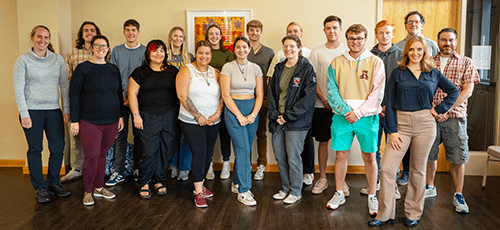
The full summer research cohort at the opening June brunch. (photo Pat Bohan)
*
Colby Fane-Cushing ’25: The Integration of EEG Biofeedback into Virtual Reality-Delivered Meditation’ Faculty mentors: Professor Melissa VanderKaay Tomasulo, Psychology Department, and Professor Dagan Loisel, Biology Department
Fane-Cushing this summer was continuing his research funded by NASA’s Space Grant College and Fellowship Program. Last year, he and a group of student researchers looked at whether virtual reality-delivered meditation impacted a person’s anxiety and stress levels as compared with non-virtual reality-delivered meditation. Several measures were used to show the effects, including saliva samples of the subjects and their heart rates. This year, Fane-Cushing had hoped to use EEG biofeedback to monitor people’s brain waves while engaging in meditation and provide further data as to whether virtual reality-delivered meditation is more effective, as the results could impact the ways that astronauts manage their stress levels while in space. However, he soon discovered this summer that he could not get the headset equipment that was central to his testing to work properly since “how it collected data wasn’t what we expected,” so he switched to examining statistics from a mid-pandemic study on first responders from Saint Michael’s Fire and Rescue, using Fitbits and virtual reality meditation for data. Going forward he hopes to do similar work with Saint Michael’s student-athletes and their stress levels using a questionnaire, and his best hope is to have” some kind of virtual reality meditation for student athletes available soon” – work he said he is “psyched” to begin in the fall.
*
Adison Granger ’24: The Rise of Christian Nationalism in the United States and its Implications for Society; Faculty mentor: Professor James Byrne, Religious Studies Department
Granger has been examining the rise of Christian nationalism and its implications in different aspects of society – including in politics, racial equality, public health, religious freedom and other areas. Current research has indicated that Christian nationalism (which also encompasses some anti-Semitic groups) has many negative impacts. Along with exploring these impacts, Granger was hoping to make a prediction as to what could happen to the U.S. if Christian nationalism continues to grow and is unchallenged. Granger described Christian nationalism in the U.S. as a “cultural framework of myths — moral cultural and political values that argue the U.S. was founded to be a Christian nation and the government should be working to keep it as such.” Research this summer showed how much “boundaries and hierarchy” play into this Christian nationalism — both symbolic and physical boundaries, be it race, gender and religion, or physical, like a border wall. Christian nationalists see themselves at the top of a hierarchy and others in violation of it, Granger said. “I can’t stress enough with my project that this is something that is happening right now that we really need to be aware of in the upcoming election,” Granger said, considering that Trump and DeSantis are “going all in” on this world view, but too many voters might not have enough awareness of this issue and the threat that it poses.
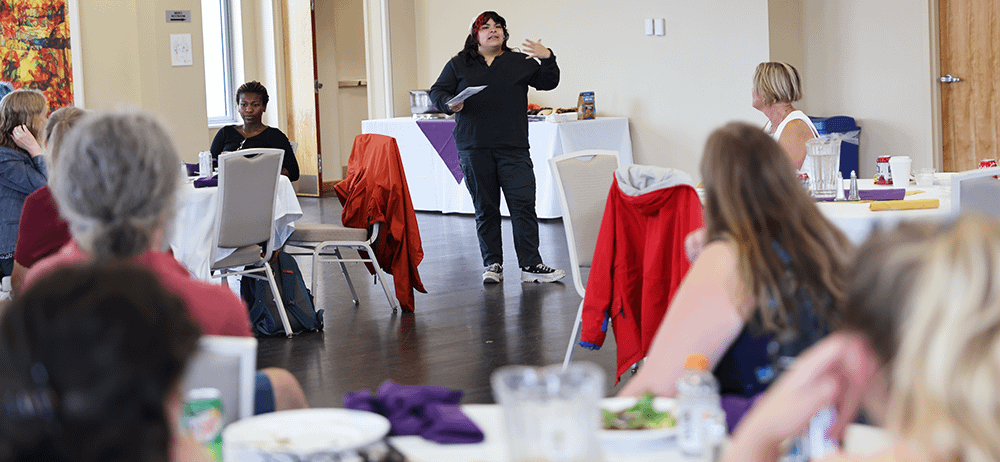
Anna Suarez makes an animated point.
